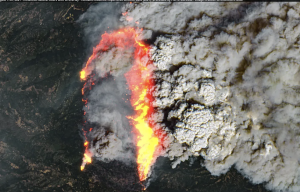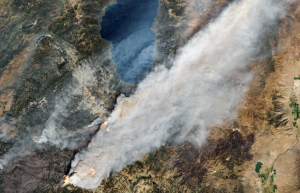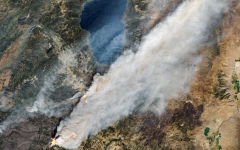
Night operations on the Caldor Fire in September, 2021. An engine crew member monitored the control line of a back burn conducted by Deschutes Engine 636. Photo by Acacia England, U.S. Forest Service (Photo:National Interagency Fire Center)
License to Burn: Wildfire as the Ultimate Public-Private Partnership (Part Two)
These forest graveyards will never return to their former glory
By Dana Tibbitts, April 29, 2024 10:50 am
The following is Part Two of “License to Burn.” Part One of the series can be found here. Part Three can be found here.
On the night of August 14, 2021—exactly 365 days after the announced Fire Stewardship MOU—a small fire flared up a few miles from Grizzly Flats—a simple brushfire. Residents had no reason to believe the United States Forest Service (USFS) would not easily put it out. But USFS was unresponsive, inexplicably pulling a half dozen Cal Fire engines and crews off the fire in the early hours, ostensibly for firefighter protection. But two days later, the fire exploded into the mountain town, a monstrous inferno. Grizzly Flats was leveled in 15 minutes.
The 60 Minutes investigation cites evidence of mismanagement, outdated tactics, and overgrown forest service land. Curiously, in a USFS agreement 10 years earlier, the forest service had promised to provide the critical clearance and mitigation measures needed to protect the town from wildfire in a high-risk fire zone. But USFS failed to deliver.
After torching Grizzly Flats, the Caldor fire began its trek to Tahoe. The aerial specter of a snouted creature, its footprint uncannily sentient in its quest for a shot at the Lake, crept grimly toward the Basin.

Tahoe residents watched in horror, wondering how long it would take fire crews to bring the infernal beast to bay. No one believed that the Caldor fire would make it past the summit or that Tahoe’s seasoned and battle-hardened fire crews wouldn’t win the day. But as days turned into weeks and the Air Quality Index (AQI) hit 400 around the Lake and hung there, residents grew concerned.
“This is fire activity happening in California we’ve never seen before,” reported Cal Fire Director Thom Porter
“Unprecedented,” declared the Washington Post.
Waiting in the wings, a timber baron vowed, “We’ll be in there before the smoke is out.”
By August 24, the smoke and ash became so bad that people were self-evacuating just to get a breath of fresh air. Alarm bells started going off, metaphorically at least, as Caldor made its steep climb to the summit. If it crossed the ridgeline, things would get ugly. Insurance agents paced anxiously, tracking the firestorm and weather conditions in real time, calculating how big of a hit they’d take on yet another out of control inferno.
Residents, already hard-pressed to secure fire insurance for their homes, felt like sitting ducks. The growing aura of inevitability surrounding Caldor was disturbing.
Some say USFS’ aggressive clearance measures saved the day. But the truth is, residents of the Tahoe Basin got a miraculous break. Tahoe firefighters were unrelenting, even after being turned away from active fire lines and told to go home by USFS Fire Chiefs. And most importantly, forecasted high winds never materialized. As Public Information officer Dominic Polito said, “If we’d had the same weather [wind] and fire behavior continue for two more days, we would have had a real problem. So, there was a little bit of divine mercy.”
Sierra-at-Tahoe Resort and their neighbors in the Phillips tract could have used more of that mercy. After years of USFS refusal to remove massive brush piles just feet from their cabins and repeated fire warnings from resident Laura Koscki, and others, they watched their cabins go up in flames. Huge slash piles of logging debris allowed the fire to ladder up adjacent trees, setting canopies ablaze and everything else with it.
Frustrated residents called out USFS inaction, “We watched battalion chiefs and sheriff department officers have a frat party on Hwy 50 for hours as an out-of-control back fire got away from an under-manned hot shot crew in the town of Strawberry. Bulldozers sat on their trailers while crews stood around drinking coffee and laughing. Cal Fire dozers didn’t cut us a single fire break.”

By September 3, while trees were still smoldering, and smoke and ash hung acrid in the air, the buzz of chainsaws could be heard humming along what remained of the devastated 40-mile corridor of Caldor. Full-scale operations were already in place to remove great carcasses of ancient trees and roll them away. One Phillips tract neighbor remarked, “Seems like they worked a lot harder at removing those burned trees than stopping that fire in the first place.”
Once the first tiers of old-growth timber were cleared, two lanes of US 50 finally opened September 21.
The devastation was heartbreaking. It was impossible to pass through these charred remains without tears. Watching helmeted crews and vast logging trucks haul away the ravaged remnant of a once magnificent forest was a funeral procession for months.
Resilience? Restoration? 222,000 acres is a lot of lost forest. These forest graveyards will never return to their former glory.
Brooding on a hearse of stricken timbers triggers a flashback to an unprecedented lumber shortage. In recent memory, it had been nearly impossible to find wood by the linear foot at Lowes or Home Depot.
For months on end, the buzz saws continued as great trees piled up on off US 50 in Carson City, Nevada, on a vacant 40-acre lot belonging to the Washoe Tribe, rumored to be the site of a new sawmill. An alliance of powerhouse players, principal investors, and heavy hitters were lining up around the Lake for a piece of the action.
Somewhere between the signing of the stewardship MOU in Sacramento and the first spark of the Caldor fire, The Tahoe Fund had quietly convened sawmill project leadership, including CEO Jon Shinn and Chairman Kevin Leary, also CEO of the Reno-based private investment firm, Hallador Investment Advisors. In February 2021, the final report was released from the Tahoe Fund’s commissioned study that examined how much supply would be available for a sawmill operation in the region.
The study cited recent funding and planning by the state of California and the USFS to increase fuel reduction treatments such as thinning as well as prescribed fire, findings presumably in support of the establishment of a new sawmill in the region. “That support should help keep the supply of logs for the sawmill flowing,” said Tahoe Fund CEO Amy Berry. “Everyone has a role to play here.”
In the next installment, Part Three will follow the money, TRPA’s role, and the alliances that coalesced around this ultimate public-private partnership.
- Study: Lake Tahoe Wildfire Evacuation Times May Exceed 14 Hours - August 29, 2024
- OPINION: Fighting Fire With Fire: The Demise of Prometheus - August 17, 2024
- OPINION–Under Fire: The Escalating Crises Of USFS Fire Policy In The West - July 12, 2024





